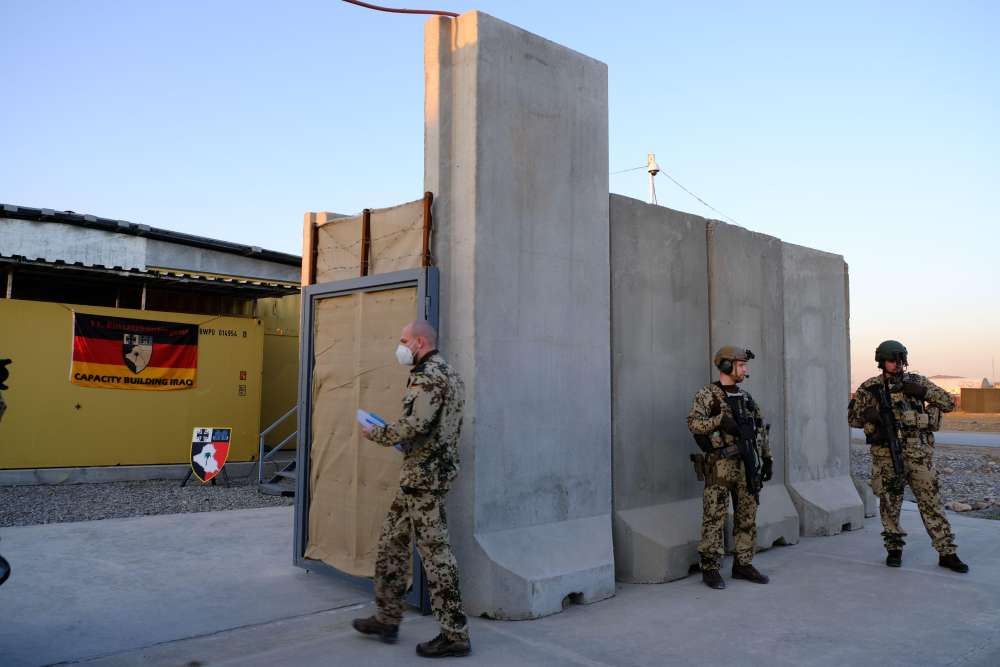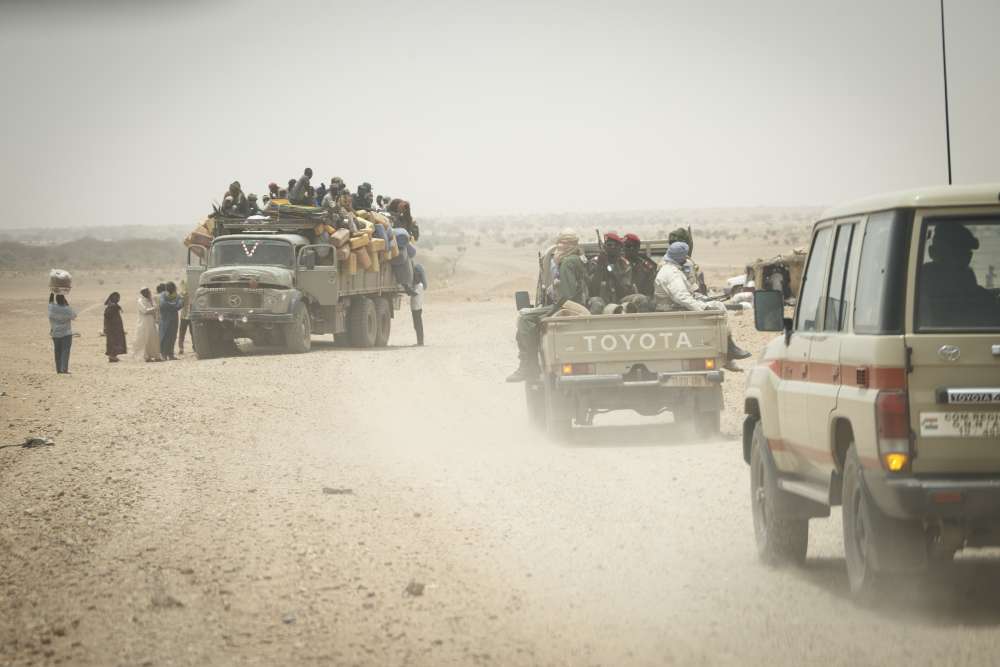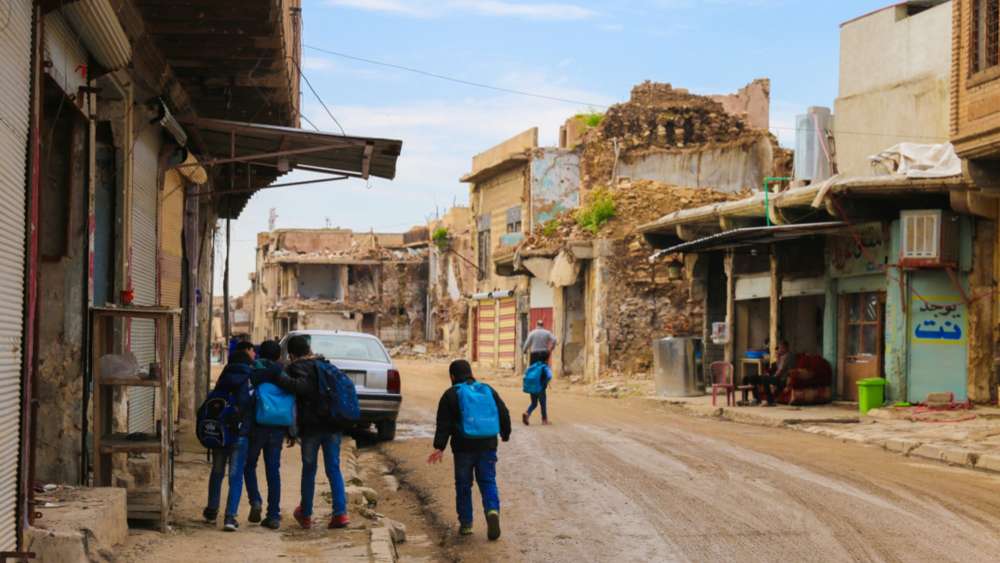Germany’s Cognitive Dissonance on Security Assistance: A Barrier to Better Protecting Civilians

(Bundeswehr/Jana Neumann)
Germany’s engagement in crisis contexts lacks an overarching vision – but without a vision, no mid-level policies and no policy architecture that would allow Berlin to manage the dilemmas of engaging in difficult environments and reduce the risk of causing unintended harm.
Over the last two decades, Germany’s foreign policy principles and commitments to key international partners and allies have drawn it ever closer to active engagement in conflict – from troop deployments in places like Mali and Afghanistan, to increasing demands for robust security assistance in Iraq, Niger or Somalia, to – most recently – assistance to Ukraine. So one might argue that Germany has been increasingly pulled into kinetic and hostile environments – if not always directly, then at least indirectly in the form of security assistance. However, Berlin’s ability to guide and shape that engagement in accordance with German principles has been hampered by a lack of overarching vision. This is where Germany’s new National Security Strategy may come in: by articulating such a vision, which could provide the necessary structure and architecture that allows the country’s security institutions to develop appropriate mid-level policies and guidance.
Germany was one of the leading troop contributors in Afghanistan, a country that from 2010 onward was an incredibly hostile environment. Since 2013, Germany has also been sending peacekeeping troops and other international security assistance to Mali. And German security assistance has been prominent in other counter-insurgency or stabilization contexts as well – in Iraq during the campaign against ISIL, in support of local partners and the international mission in Somalia, or in bilateral or multilateral training missions like those ongoing in Niger. The latter may well become the more prominent model in the years to come (in contrast to the many-boots on-the-ground approach seen in places like Afghanistan or Mali). However, all of these examples have one thing in common: they posed or pose equally challenging dilemmas for Germany in terms of having a consistent and ethical security practice.
» Germany has been increasingly pulled into kinetic and hostile environments – if not always directly, then at least indirectly in the form of security assistance. «
While Germany’s foreign policy and security assistance has step by step been moving away from its pacifist roots toward more overt engagement in international security matters, these steps have often been ad hoc and driven by events. That is to say: they have been demanded of Germany, by the pressure of the moment or alliance commitments. As a result, there has been a growing disconnect between German security policy in practice and the top-level vision or architecture. That is a problem, because a well-articulated, top-level national security vision is a prerequisite for the kinds of mid-level policies and supporting architecture that help navigate the dilemmas and challenges that come with engaging in environments like Afghanistan or Mali. To illustrate how that might be the case, it is helpful to reflect on Germany’s past involvement – either directly with peacekeepers or stabilization support on the ground, or indirectly through security sector assistance (SSA) – in the past two decades.
Key Points:
- Examples like Afghanistan or Iraq illustrate that there is a growing disconnect between the reality of German security assistance and the lack of a top-level vision or policy infrastructure.
- Because of its traditionally defensive and non-interventionist stance, Germany has erected a normative barrier that prevents it from really grappling with the dilemmas of deploying force or supporting it in crisis contexts.
- In its new security strategy, Berlin should formulate a new vision of German security engagement abroad – one that reconciles reality and self-perception and lays the foundation for effective mid-level policies and a corresponding policymaking architecture.
Afghanistan: Unprepared and Under-Supported
When major troop contributors to the International Security Assistance Force in Afghanistan (ISAF) began to expand outward from the capital in the 2005 to 2006 period, Germany volunteered its troops for the (at that point) safe and stable province of Kunduz. Later, Berlin expanded the German bases and development responsibilities to neighboring provinces in northern Afghanistan. But the Germans got more than they bargained for. Though initially less volatile than the Taliban heartland in the south and east of Afghanistan, the country’s north was a vipers’ nest of warlords and militia groups who quickly captured the provincial state apparatus. Their predatory and abusive behavior toward parts of the population and infighting between rival militias soon turned provinces like Kunduz into hotly contested areas. In 2015, Kunduz city became the first provincial capital to be retaken by the Taliban.
German forces who were deployed in this increasingly volatile situation found themselves unprepared and under-supported. They were fighting against a full-blown insurgency but were only backed by a force posture and level of preparation, equipment and rules adapted to a peacetime – or at best a peacekeeping – situation. I interviewed a number of German forces who had served in these areas between 2008 and 2012, for a project on NATO member states’ rules of engagement related to self-defense and civilian protection. Many of the commanders and former German service people I spoke to described an approach that was out of step with the situation on the ground, leaving them feeling personally exposed.
But Germany’s mismatched posture was not just a question of personnel risk or mission accomplishment. Although German forces took an overall more defensive stance and restrained approach, civilian casualties are nonetheless inevitable in such environments. While most other ISAF member states were at the time already well on their way to developing specific civilian harm reduction policies and setting up funds to make amends and offer support to those affected by unintended harm, Germany had no such policy. Initially, when German forces unintentionally caused harm to Afghan civilians, soldiers simply passed the hat around to offer some means of support to the respective families.
» Germany’s force posture, which was premised on a defensive, peacekeeping mandate alone, was not prepared for the risk of civilian harm – and so policies were never developed to prepare for that eventuality. «
This was not because German policymakers or forces were unsympathetic to the plight of civilian suffering. Rather, Germany’s force posture, which was premised on a defensive, peacekeeping mandate alone, was not prepared for the risk of civilian harm – and so policies were never developed to prepare for that eventuality.
This became even more unsustainable after a German-ordered strike on a fuel tanker in Kunduz in 2009 resulted in as many as 100 civilian deaths. A year after the incident, and following threats of civil litigation in Germany (which did go forward but ultimately did not prevail), the German Ministry of Defense made special arrangements to pay 4,000 euros as a form of ex-gratia amends (read: not formal compensation) to each victim’s family. Research by myself and others on making amends after events of civilian harm has suggested that such practices or payments have the best chance of helping affected families and survivors, and of encouraging reconciliation and reducing the chance of blowback, when they happen immediately after an incident. But even that is only possible when there is the appropriate level of policy decision-making and funding support that enables commanders on the ground to respond promptly. After a year of foot-dragging, the 4,000 euros offered to the Kunduz victims was largely viewed as too little, too late. Plus, the Kunduz case wound its way through costly and time-consuming litigation for more than a decade.
The issue of a lack of preparedness to bolster Germany’s international security commitments can also be seen in a range of situations where Germany supported partners, which is increasingly the main direction of German international security interventions. From spending less than 20 million euros in 2015, Germany upped its financial assistance to more than 600 million euros from 2017 to 2021 – spent on training and equipping partner security forces in Iraq, Jordan, Tunisia, Mali, Nigeria, Burkina Faso, and Niger.
Iraq: A Lack of Supporting Policy Infrastructure
Such security sector assistance is also a form of intervention – and it requires a dedicated national security vision that, to be implemented responsibly, needs to backed up by appropriate mid-level policies. Although Germany has taken steps in this direction – for instance, the 2016 German “Weißbuch”(white paper) on security sector policy or its more ambitious 2018/2019 security sector assistance strategy – German partner assistance policies in the field have still tended to be more event-driven and have lacked the clarity and corresponding architecture to fully support the emerging range of Berlin’s assistance to partners.
The example of Iraq illustrates this. After ISIL took over large chunks of north and central Iraq in 2014, Germany (along with other international partners) rallied to the defense of the Iraqi government and of the Kurdistan Regional Government within it, which was on the frontline of much of the fighting. As ISIL committed more and more atrocities, including the near-genocide of the Yezidi subpopulation, Germany agreed to not only provide training to the Kurdish Peshmerga fighters, but also to send significant amounts of arms, including Milan rockets.
Domestically, the decision was controversial and hotly debated. This was well before the current Ukraine conflict and at that time, it was virtually unprecedented in Germany’s post-World War II history to send weapons into an active conflict zone. Even more troublingly for many Germans, the government would be sending this lethal weaponry to a sub-state regional government with kleptocratic tendencies and a history of both infighting and armed rebellion against the central government in Baghdad.
Ultimately, Germany’s principled foreign policy position to ‘never again’ stand by as atrocities were being committed won out. But there was then no supporting policy infrastructure in place to ensure that related risks could be managed or that the assistance would be provided transparently. I spoke to German officers deployed with the Ministry of Peshmerga Affairs as well as German diplomats charged with overseeing the Peshmerga assistance. They had no means of verifying whom they were training or where the arms were going, much less of using this assistance to condition the sort of democratic accountability and security sector reforms that were intended by Germany. “They are doing things we don’t like all the time,” one German officer noted, giving the example of documentation that proved Peshmerga were razing Arab homes and villages. But where that happened, he added, “You can make pressure on them to stop, or threaten to quit, but what can you really do?” What is more, many of the German weapons resurfaced on the black market, and there were accusations that the Kurds had used German-supplied Milan rockets against the Iraqi army after a 2017 Kurdish independence bid caused a confrontation between Kurdistan and Baghdad.
This example, too, demonstrates common issues in SSA policies: all international donors in Iraq (on both the Peshmerga and Baghdad sides) struggled with issues of conditionality and control, particularly when dealing with sub-state partners. Nonetheless, Germany’s traditionally defensive and non-interventionist stance has erected an additional normative barrier to really engaging with the dilemmas connected to the deployment of or support for uses of force. This has remained true even as Germany’s foreign policy principles and commitments have, in practice, drawn it ever more frequently into these situations.
Toward a More Consistent Security Assistance Posture
One explanation for this: Germany does not like to think of itself as a country that might direct operations leading to hundreds of civilian casualties (as in Afghanistan), that provides weapons and training that might foment civil war or reinforce autocratic control (as in Iraq and Mali), or that backs rebels (the dilemma that Germany and other Western partners faced in Syria) or clan-based militias (the choice Germany and other actors currently face in Somalia). This cognitive dissonance hinders efforts to adequately prepare German forces, diplomats and bureaucrats for the dilemmas they inevitably face in crisis contexts – with dire consequences.
A first step to remedy that would be a national security strategy that accurately captures the real status quo of Germany’s foreign and security policy posture, not that of two decades ago. It should also spell out red lines and draw boundaries on the types of support or intervention Germany deems possible and likely, thus allowing for meaningful prevention and mitigation of threats as well as better preparedness to deal with crisis situations in a principled manner where they arise.
» A first step would be a national security strategy that accurately captures the real status quo of Germany’s foreign and security policy posture, not that of two decades ago. «
But this would then have to be followed by the hard work of developing the requisite mid-level policies as well as the corresponding policy architecture needed to robustly implement such policies. This is a multi-year and sometimes even a multi-decade process. The United States, for example, has been on the learning curve of how to improve its civilian protection and harm reduction policies for much longer than Germany. Yet only in 2022 did it release a dedicated Civilian Harm Mitigation and Response Action Plan, which operationalizes policies on mitigating and responding to civilian harm that have emerged over the last decade.
In Germany’s case, the process of evolution might be much faster because it does not start from scratch: Berlin can draw on a well of substantial thinking about how to increasingly infuse German security sector support with governance and accountability considerations, or how to improve its modalities of delivering SSA in ways that prevent the issues seen in Iraq or Afghanistan. And indeed, some of the strongest steps toward improving transparency with regard to SSA have happened recently in response to the crisis in Ukraine.
But more needs to be done to better protect civilians and reduce harm in international crisis engagement. As other authors on this blog have pointed out, there is much more that Germany in particular could do to elaborate its civilian harm reduction principles, in line with and reinforcement of similar developments and policies within NATO. While German forces may be less frequently on the frontlines in the future, as noted above, the Ukraine conflict has spotlighted more than anything the need to reinforce international humanitarian law, both normatively and in practice. In addition, civilian protection principles and standards not only matter with regard to the conduct of a country’s own forces, but also within the scope of its assistance to others.
Over the last two decades, Germany’s foreign and security policy has evolved substantially, in ways that have led the country away from its previous defensive posture but have allowed it to meaningfully deliver on its commitments to human rights and collective security. Articulating this new force posture and position in its upcoming National Security Strategy would open the door for Germany to take even more meaningful steps – namely fleshing out the country’s policies on civilian protection and partner support as well as the military rules of engagement and accountability that are necessary to realize this vision in practice.
Erica Gaston
Senior Policy Advisor & Head of the Conflict Prevention and Sustaining Peace Programme, United Nations University Centre for Policy Research (UNU-CPR)
Weiterlesen

Germany’s Role as a Global Leader in Stabilization
Stabilization can be one of the most effective ways to help countries prevent or emerge from violent conflict. Germany already leads the way – and should expand on this role with its new security strategy.

German Security Policy in Africa: New Enemy, Same Mistakes?
Despite the rising power competition with Russia in Africa, Western countries should avoid repeating their mistakes of past counter-terrorism and stabilization campaigns. How threat inflation and no-strings-attached security assistance hinders the chances for peace.

Prioritizing the Protection of Civilians in National Security
When drafting security policy, those most affected by conflict are often missing from the equation. Applying a protection lens to Germany’s upcoming security strategy would be a way of putting civilians first.